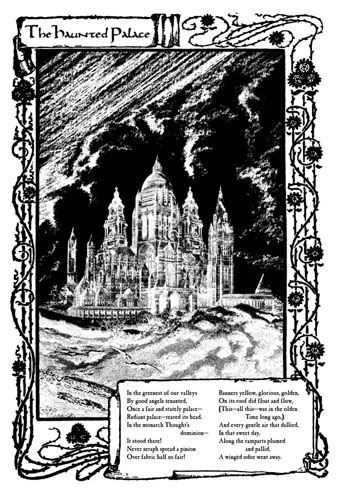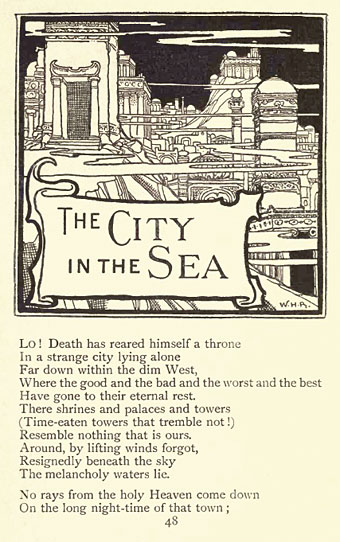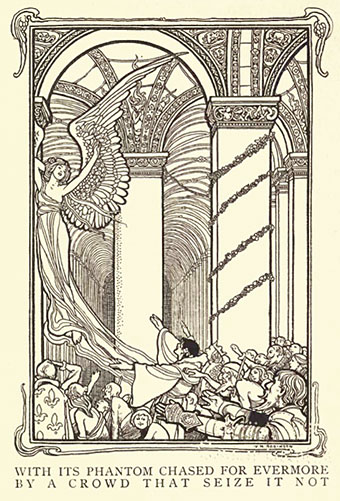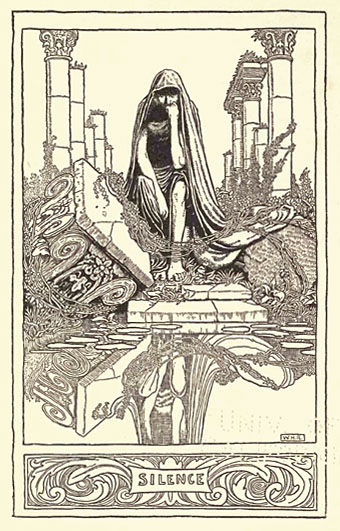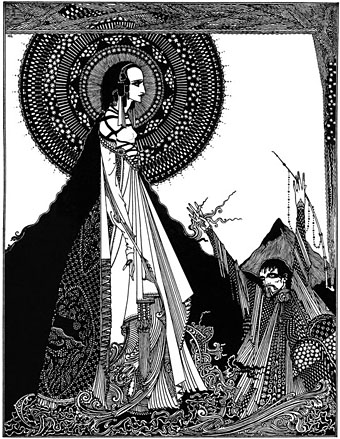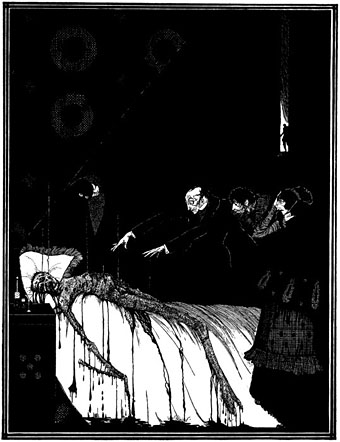More Poe-etry and a work of my own this time, one of three pages illustrating Poe’s poem produced for the a Graphics Classics collection in 2004. These aren’t showcased anywhere on this site since I’ve never thought I did a very good job with the commission, it was a poor attempt to imitate Sätty’s collage engraving style but I didn’t give myself enough time to work on it. As it was, whatever I would have done wouldn’t fit too well with the Graphics Classics style which tends to be far more cartoony than anything I do. The book is still in print, however, should you require a copy.
Tag: Edgar Allan Poe
Poe at 200
Poe by Harry Clarke.
Happy birthday Edgar Allan Poe, born two hundred years ago today. I nearly missed this anniversary after a busy weekend. Rather than add to the mountain of praise for the writer, I thought I’d list some favourites among the numerous Poe-derived works in different media.
Illustrated books
For me the Harry Clarke edition of 1919 (later reworked with colour plates) has always been definitive. Many first-class artists have tried their hand at depicting Poe’s stories and poems, among them Aubrey Beardsley, Gustave Doré, Arthur Rackham, W. Heath Robinson and Edmund Dulac; none complements the morbid atmosphere and florid prose as well as Clarke does. And if it’s horror you need, Clarke’s depiction of The Premature Burial could scarcely be improved upon.
Honourable mention should be made of two less well-known works, Wilfried Sätty’s The Illustrated Edgar Allan Poe (1976) and Visions of Poe (1988) by Simon Marsden. I wrote about Sätty’s collage engravings in Strange Attractor 2, and Sätty’s style was eminently suited to Poe’s work. Marsden’s photographs of old castles and decaying mansions are justly celebrated but in book form often seem in search of a subject beyond a general Gothic spookiness or a recounting of spectral anecdotes. His selection of Poe stories and poems is a great match for the photos, one of which, a view of Monument Valley for The Colloquy of Monos and Una, was also used on a Picador cover for Blood Meridian by Cormac McCarthy.
Recordings
These are legion but among the outstanding one-off tracks I’d note two poems set to music, Dream Within a Dream from Propaganda‘s 1985 album, A Secret Wish, and The Lake by Antony & The Johnsons. The latter appeared on the landmark Golden Apples of the Sun compilation and also on Antony’s own The Lake EP.
Among the full-length works, Hal Willner’s 1997 2-CD collection Closed on Account of Rabies features lengthy readings set to music from a typically eclectic Willner line-up: Marianne Faithfull, Christopher Walken, Iggy Pop, Diamanda Galás, Gavin Friday, Dr John, Deborah Harry, Jeff Buckley (one of the last recordings before his untimely death) and Gabriel Byrne. Byrne’s reading of The Masque of the Red Death is tremendous and the whole package is decked out in Ralph Steadman graphics.
Antony Hegarty appears again on another double-disc set, Lou Reed’s The Raven (2003), a very eccentric approach to Poe which I suspect I’m in the minority in enjoying as much as I do. An uneven mix of songs and reading/performances, Reed updates some Poe poems while others are presented straight and to often stunning effect by (among others) Willem Defoe, Steve Buscemi, Laurie Anderson, David Bowie, Amanda Plummer and Elizabeth Ashley.
Films
Once again, there’s too many films but The Masque of the Red Death (1964) has always been my favourite of the Roger Corman adaptations, not least for the presence of Jane Asher, Patrick Magee and (behind the camera) Nicolas Roeg. I wrote last May about the animated version of The Tell-Tale Heart from UPA. That adaptation, with narration by James Mason, is still on YouTube so if you haven’t seen it yet you can celebrate Poe’s anniversary by watching it right now.
Elsewhere on { feuilleton }
• The illustrators archive
Previously on { feuilleton }
• The Tell-Tale Heart from UPA
• William Heath Robinson’s illustrated Poe
• The art of Harry Clarke, 1889–1931
William Heath Robinson’s illustrated Poe
Another gem from the Internet Archive collection of scans from North American libraries. This edition of the poems of Edgar Allan Poe from 1900 was illustrated by William Heath Robinson (1872–1944), an artist whose later drawings of quirky inventions have completely overshadowed his earlier books, as well as the work of his equally talented older brother, Charles. I’m probably in the minority in preferring Heath Robinson’s book illustration to his later works, and this edition of Poe is a superb example of his mastery of line and space. It can’t compete with Harry Clarke’s Poe, of course, but then neither can anything else. WHR wasn’t really suited to the darker side of literature but he acquits himself here far better than Arthur Rackham did when he attempted his own Poe collection in 1935.
• Bud Plant’s W Heath Robinson page
• W. Heath Robinson’s fairy tale illustrations
The Conqueror Worm.
Elsewhere on { feuilleton }
• The illustrators archive
A playlist for Halloween
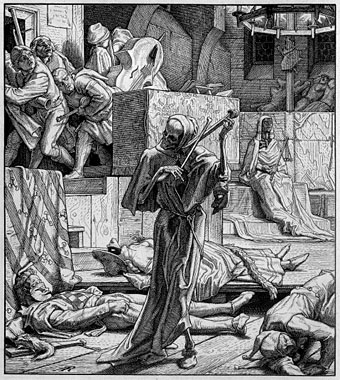
Der Tod als Erwürger (1851) by Alfred Rethel.
It’s a fact (sad or otherwise) that a substantial percentage of my music collection would make good Halloween listening but in that percentage a number of works are prominent as spooky favourites. So here’s another list to add to those already clogging the world’s servers, in no particular order:
Theme from Halloween (1978) by John Carpenter & Alan Howarth.
What a surprise… All John Carpenter‘s early films have electronic scores and great themes, Halloween being the most memorable, and one that’s gradually infected the wider musical culture as various hip hop borrowings and Heat Miser by Massive Attack demonstrate.
Monster Mash (1962) by Bobby “Boris” Pickett.
The ultimate Halloween novelty record. A host of imitators followed the success of this single while poor Bobby struggled to be more than a one-hit wonder. It wasn’t to be, this was his finest hour. Available on These Ghoulish Things: Horror Hits for Halloween with some radio spots by Bobby and a selection of other horror-themed rock’n’roll songs.
The Divine Punishment (1986) & Saint of the Pit (1988) by Diamanda Galás.
Parts 1 & 2 of Galás’s Masque of the Red Death, a “plague mass” trilogy based on the AIDS epidemic. These remain my favourite records by Ms Galás; on the first she reads/sings passages from the Old Testament accompanied by sinister keyboards, making the Bible sound as steeped in evil and metaphysical dread as the Necronomicon. On Saint of the Pit she turns her attention to French poets of the 19th century (Baudelaire, Gérard de Nerval & Tristan Corbière) while unleashing the full power of her operatic vocalizations. Einstürzende Neubauten’s FM Einheit adds some thundering drums. “Correct playback possible at maximum volume only.” Amen to that.
The Visitation (1969) by White Noise.
An electronic collage piece about a ghostly lover returning to his grieving girlfriend. White Noise were David Vorhaus working alongside BBC Radiophonic Workshop pioneers Delia Derbyshire and Brian Hodgson to create an early work of British electronica and dark psychedelia. The Visitation makes full use of Derbyshire and Hodgson’s inventive tape effects and probably accounts for them being asked to score The Legend of Hell House a few years later. Immediately following this is the drums and screams piece, Electric Storm In Hell; play this loud and watch the blood drain from the faces of your Halloween guests.
Zeit (1972) by Tangerine Dream.
Subtitled “A largo in four movements”, Zeit is Tangerine Dream’s most subtle and restrained album, four long tracks of droning atmospherics.
The Masque of the Red Death (1997) read by Gabriel Byrne.
From Closed On Account Of Rabies, a Poe-themed anthology arranged by Hal Willner. The readings are of variable quality; Christopher Walken’s The Raven is effective (although I prefer Willem Defoe’s amended version on Lou Reed’s The Raven) while Dr John reads Berenice like one of Poe’s somnambulists. Gabriel Byrne shows how these things should be done.
De Natura Sonoris no. 2 (1971) by Krzysztof Penderecki.
More familiar to people as “music from The Shining“, this piece, along with much of the Polish composer‘s early work, really does sound like music in search of a horror film. His cheerily-titled Threnody For The Victims Of Hiroshima is one piece that won’t be used to sell cars any time soon. Kubrick also used Penderecki’s equally chilling The Dream of Jacob for The Shining score, together with pieces by Ligeti and Bartók.
Treetop Drive (1994) by Deathprod.
Helge Sten is a Norwegian electronic experimentalist whose solo work is released under the Deathprod name. “Electronic” these days often means using laptops and the latest keyboard and sampling equipment. Deathprod music is created on old equipment which renders its provenance opaque leaving the listener to concentrate on the sounds rather than be troubled by how they might have been created. The noises on the deceptively-titled Treetop Drive are a disturbing series of slow loops with squalling chords, anguished shrieks and some massive foghorn rumble that seems to emanate from the depths of Davy Jones’ Locker. Play it in the dark and feel the world ending.
Ouroborindra (2005) by Eric Zann.
Another collection of sinister electronica from the Ghost Box label (see this earlier post), referencing HP Lovecraft and Arthur Machen’s masterpiece, The White People. Spectral presences haunting the margins of the radio spectrum.
Theme from The Addams Family (1964) by Vic Mizzy.
Never the Munsters, always the Addams Family! If you don’t know the difference, you must be dead.
Happy Halloween!
Previously on { feuilleton }
• The music of the Wicker Man
The art of Harry Clarke, 1889–1931
The Masque of the Red Death.
Halloween approaches so let’s consider the finest illustrator of Edgar Allan Poe’s stories, Irish artist Harry Clarke. Aubrey Beardsley once declared “I am grotesque or I am nothing” yet even his grotesquery—which could be considerable—struggled to do justice to Poe. Clarke, the best of the post-Beardsley illustrators, found a perfect match in the Boston writer’s Tales of Mystery and Imagination, his edition being published by Harrap in 1919. He could decorate fairy tales with the best of the great Edwardian book illustrators but a flair for the morbid blossomed when he found Poe. Only his later masterpiece, Goethe’s Faust, improved on the dark splendour of these drawings. “Never before have these marvellous tales been visually interpreted with such flesh-creeping, brain-tainting illusions of horror, terror and the unspeakable” wrote a critic in The Studio.
Lots more pictures at Grandma’s Graphics (although none of the colour plates, unfortunately) including many of the Faust drawings. Wikipedia has photos of some of Clarke’s incredible stained-glass windows, as does Bud Plant’s biography page.
Ligeia.
The Facts in the Case of M. Valdemar.
Elsewhere on { feuilleton }
• The illustrators archive

